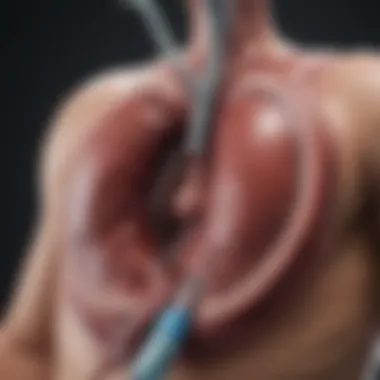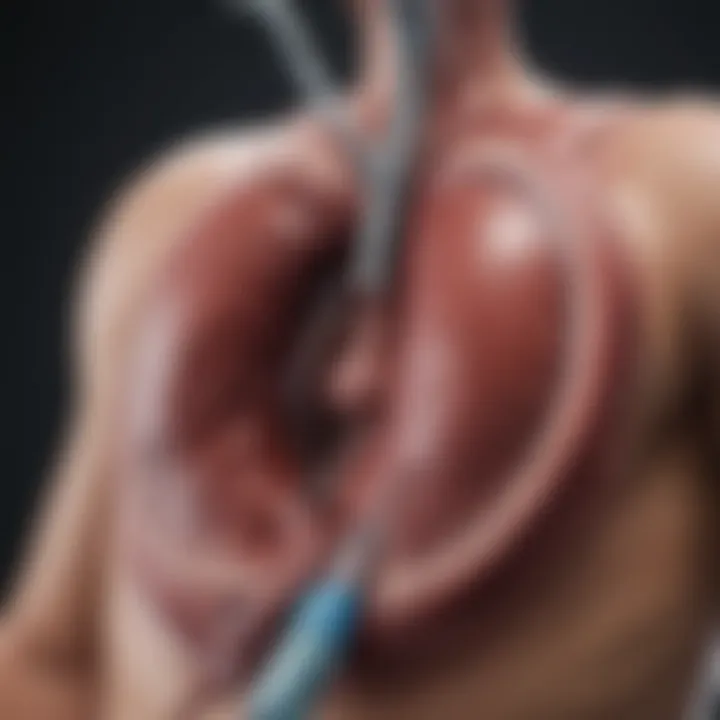Total Nephrectomy vs Radical Nephrectomy: Key Differences


Intro
Renal surgeries play a crucial role in treating various kidney diseases. Two primary surgical interventions are total nephrectomy and radical nephrectomy. Understanding the differences between these procedures is essential for healthcare professionals, patients, and their families. This section aims to introduce the topic and highlight the importance of discerning between these surgical methods.
Total nephrectomy involves the complete removal of one kidney, along with surrounding tissues and potentially involved structures. In contrast, radical nephrectomy generally includes the removal of the entire kidney, along with the surrounding fat, nearby lymph nodes, and some adjacent organs, depending on the specific case. Each procedure has its specific indications, risks, and postoperative care guidelines that require careful consideration.
In this article, we will delve into the fundamental aspects of both surgeries. We will discuss the indications for each type of nephrectomy, dissect the procedural differences, evaluate complications, outline recovery pathways, and consider the long-term implications for patients. This comprehensive analysis also leans on current research and clinical studies to support our discussions, guiding readers through informed decisions related to renal surgeries.
Intro
The examination of total nephrectomy versus radical nephrectomy carries significant weight in contemporary urological practice. Understanding the distinctions between these two surgical procedures is essential, as both aim to address renal conditions but differ in technique, context, and outcomes. By dissecting this topic, the article seeks to provide clarity around when and why each approach is utilized, as well as the implications for patient care.
In addressing nephrectomy, we explore various aspects that influence surgical decision-making. Both total nephrectomy and radical nephrectomy have their own indications based on the pathology involved, emphasizing the importance of accurate diagnosis and tailored treatment plans for optimal patient outcomes. The nuances between them can affect recovery, potential complications, and overall prognosis, making it critical for healthcare professionals, students, and researchers to be well-informed.
The aim here is to not only distinguish between these surgical options but to also equip the reader with comprehensive insights into their applications, benefits, and risks. This understanding fosters informed discussions among patients and healthcare teams, promoting shared decision-making that aligns with patient values and preferences.
Understanding Nephrectomy
Nephrectomy refers to the surgical removal of one or both kidneys. It is performed for various medical reasons, most commonly for cancer, traumatic injuries, or severe kidney disease. The type of nephrectomy conducted depends on the specific circumstances surrounding each patient’s condition. Total nephrectomy involves complete removal of the kidney along with a portion of surrounding tissue, while radical nephrectomy entails removing the kidney as well as adjacent structures such as the adrenal gland and surrounding fat.
The technique chosen will often reflect the underlying disease process and the intent behind surgical intervention. As medical advances continue to enhance surgical techniques, understanding renal surgeries is vital for aspiring medical professionals and practitioners alike. With better knowledge, they can comprehend complex cases and participate in multidisciplinary approaches to patient management.
Historical Perspective
The history of nephrectomy dates back to the 19th century, evolving significantly over the years. Initially, surgical techniques were rudimentary, and mortality rates were high. With advancements in anesthesia and aseptic techniques, the safety and efficacy of nephrectomy improved. Significant milestones occurred in the early 20th century when radical nephrectomy was established for renal cancer as a standard treatment modality.
The work of notable surgeons contributed to the refinement of this approach, establishing protocols that shaped modern practices. As research progressed, it became clear that careful patient selection and advances in diagnostic imaging would alter the landscape of surgical decision-making. Today, nephrectomy is often approached with minimally invasive techniques that reduce recovery times and complications, reflecting an ongoing commitment to patient safety and care quality.
Nephrectomy has changed from a high-risk procedure to a more manageable intervention, largely due to surgical innovations and better understanding of renal pathology.
This historical overview underscores the importance of continual learning and adaptation in surgical practice. Understanding where nephrectomy began helps professionals appreciate current methodologies and informs discussions about future trends and research in renal surgery.
Defining Total Nephrectomy
Total nephrectomy is a significant surgical procedure in the field of urology, with profound implications for patients facing severe renal disease. Understanding this technique is crucial for both medical professionals and patients, as it lays the groundwork for informed treatment decisions. Total nephrectomy involves the complete removal of one kidney, and it is performed for various reasons, including the management of renal tumors, severe trauma, or chronic kidney disease. This section aims to illuminate key elements surrounding total nephrectomy, emphasizing its importance, benefits, and considerations.
Procedure Overview
The procedure for total nephrectomy can be approached in two primary ways: open surgery and laparoscopic surgery. In open surgery, a larger incision is made in the flank region to access the kidney directly. This method may offer better visibility and the ability to address complex conditions but often results in longer recovery times. Laparoscopic total nephrectomy, on the other hand, involves smaller incisions and utilizes a camera and specialized instruments. This technique generally leads to reduced postoperative pain and quicker recovery.
The choice of technique often depends on the specific clinical scenario, the patient's overall health, and the surgeon's expertise.
Both methods necessitate general anesthesia, and careful perioperative management is essential to optimize patient outcomes.
Indications for Surgery
Various conditions may necessitate a total nephrectomy. Some of the primary indications are:
- Renal Cell Carcinoma: This is the most common cancer of the kidney requiring surgical intervention.
- Severe Kidney Trauma: Cases where the kidney has been irreversibly damaged due to injury could necessitate its removal.
- Congenital Abnormalities: Certain structural defects of the kidney may require complete removal.
- Cysts or Tumors: Non-cancerous growths that lead to significant symptoms may also warrant total nephrectomy.
In some scenarios, the decision to proceed with total nephrectomy arises from the need to preserve remaining renal function, particularly when the contralateral kidney has pre-existing impairment.
Outcomes and Expectations
Patients may wonder about the outcomes and expectations following a total nephrectomy. Generally, the prognosis depends on the condition leading to the surgery, but many can expect positive outcomes with proper management. Survival rates for renal cell carcinoma, particularly when identified early, are significantly favorable. Outcomes also include:
- Management of symptoms: Many patients experience relief from symptoms such as pain and blood in the urine.
- Adjustment to Single Kidney Function: Most individuals can lead a normal life with one kidney, though they may need regular monitoring of renal function.
Postoperative recovery varies by surgical approach, underlying health, and adherence to postoperative care instructions. Most patients can expect to resume normal activities within a few weeks, barring complications.
In summary, total nephrectomy plays a critical role in addressing severe renal disease. The procedure's strategic implementation, coupled with ongoing research and evolving surgical techniques, holds promise for enhanced patient care and outcomes in the field of renal surgery.
Exploring Radical Nephrectomy
Radical nephrectomy plays a crucial role in the surgical management of kidney-related diseases, particularly renal cell carcinoma. Understanding its specifics helps in delineating its importance and applicability within the broader context of nephrectomy procedures. Through this section, we will examine the surgical techniques, patient selection criteria, and anticipated outcomes, providing a comprehensive overview of what radical nephrectomy entails.
Surgical Technique Details
Radical nephrectomy involves the removal of an entire kidney along with surrounding fat, adrenal gland, and potentially involved lymph nodes. The approach can be either open or minimally invasive, with laparoscopic methods becoming increasingly popular due to their associated benefits.
- Open Radical Nephrectomy: This traditional approach utilizes a significant incision, typically in the flank area. This method may increase the visibility for the surgeon but often results in longer recovery time and more postoperative pain.
- Laparoscopic Radical Nephrectomy: Utilizes small incisions and specialized instruments to perform the procedure under video guidance. This approach minimizes tissue damage and often leads to shorter hospital stays, reduced discomfort, and a faster return to normal activities.
The choice between these techniques can depend on multiple factors, including tumor size, location, and patient health status. Each surgical method has its indications and considerations, which should be weighed carefully before proceeding.
Indications and Patient Selection
Indications for radical nephrectomy generally encompass circumstances where the kidney is affected by malignant tumors. Specific considerations include:
- Local Tumors: Radical nephrectomy is typically indicated for localized renal cell carcinoma. It is often the treatment of choice when tumors are confined to the kidney without evidence of metastasis.
- Kidney Function: Patients with only one functioning kidney, or severe underlying kidney conditions, must be evaluated thoroughly. Preservation of renal function may affect the surgical decision.
- Tumor Characteristics: Factors such as tumor size, grade, and renal vein involvement contribute to the determination of surgery necessity.
Patient selection also involves assessing overall health, comorbidities, and potential postoperative recovery challenges. Careful preoperative evaluations enhance the likelihood of favorable outcomes.


Projected Outcomes
Radical nephrectomy is associated with various outcomes that are essential for patient prognosis. Postoperative considerations typically include:
- Survival Rates: Studies indicate that the five-year survival rate for non-metastatic renal cell carcinoma can reach around 70%. Early intervention tends to significantly improve outcomes.
- Recurrence: The risk of cancer recurrence varies based on the tumor characteristics and staging. Regular follow-ups and monitoring are vital to manage any potential recurrences effectively.
- Long-Term Quality of Life: Many patients experience only mild disruptions in their day-to-day activities post-recovery. Long-term health can also depend on factors like maintaining remaining kidney function and lifestyle choices.
Informed decisions in radical nephrectomy are essential, as patient outcomes hinge on the appropriateness of surgical treatment considering individual circumstances and tumor characteristics.
In summary, understanding the surgical technique, patient selection criteria, and outcomes provides a holistic view of radical nephrectomy. The procedure offers significant therapeutic benefits, especially in targeted patient populations.
Procedural Differences
Understanding the procedural differences between total nephrectomy and radical nephrectomy is crucial for both patients and healthcare professionals. These distinctions influence patient outcomes, recovery times, and long-term health. This section will delve into the specific elements that set these two surgical interventions apart, helping to clarify their benefits and considerations in various clinical contexts.
Technique Comparison
Total nephrectomy involves the complete removal of a kidney and its surrounding adipose tissue, whereas radical nephrectomy entails the removal of the kidney along with the surrounding tissue, lymph nodes, and part of the surrounding organs, if necessary. This fundamental difference in scope impacts surgical complexity, runs a risk for extended recovery periods, and dictates postoperative care.
Key points of comparison include:
- Extent of Resection: Total nephrectomy focuses solely on the kidney, while radical nephrectomy addresses broader areas, targeting adjacent structures if malignancy is present.
- Surgical Duration: Typically, radical nephrectomy procedures take longer due to the extensive tissue removal and reconstruction involved.
- Recovery Challenges: Patients undergoing radical nephrectomy may experience more complications due to larger surgical wounds and greater physiological stress, impacting recovery speed.
Surgical Approaches Overview
The surgical approaches for these two techniques vary significantly as well. Both open and minimally invasive methods can be utilized, but the choice often depends on the surgical team's expertise and the patient's specific condition.
Surgical approaches can be categorized as follows:
- Open Surgery:
- Laparoscopic Techniques:
- Robotic-Assisted Surgery:
- Involves larger incisions, offering direct access to the kidney.
- Traditionally used for first-time procedures but has higher recovery times.
- Minimally invasive, using smaller incisions with the assistance of cameras.
- Often results in shorter hospital stays and quicker return to daily activities, primarily for total nephrectomy.
- A recent development enabling precision in complicated procedures.
- Suitable for both total and radical nephrectomy, although the advantages and effectiveness can vary between surgeons.
In summary, the procedural differences between total nephrectomy and radical nephrectomy have significant implications regarding technique, recovery, and potential complications. Understanding these disparities is essential for informed decision-making in renal surgery.
Complications and Risks
Understanding the potential complications and risks associated with total and radical nephrectomy is vital for patients and healthcare providers. Awareness of these factors aids in informed decision-making and sets realistic expectations. Complications can arise both during and after surgery, significantly influencing patient outcomes, recovery time, and overall quality of life.
Surgeons must carefully assess each patient’s health status and possible risk factors before proceeding with either procedure. This analysis leads to tailored surgical plans and enhances surgical success while minimizing potential harmful outcomes.
Potential Intraoperative Complications
During surgery, several intraoperative complications may occur, impacting the success of the procedure. Some common issues include:
- Hemorrhage: Excessive bleeding during the surgery can lead to significant blood loss, necessitating transfusions.
- Organ Injury: Accidental damage to surrounding organs, like the spleen or colon, can complicate the surgery and prolong recovery.
- Anesthesia Risks: Adverse reactions to anesthesia may happen, leading to respiratory complications or cardiovascular instability.
- Infection: While precautions are taken, surgical sites can become contaminated, leading to postoperative infections.
Surgeons must be skilled in managing these risks effectively. Adequate training can substantially decrease the occurrence of these complications.
Postoperative Complications
Complications may continue after surgery, affecting the patient’s recovery and quality of life. Some notable postoperative complications include:
- Infection: As mentioned, surgical sites or internal structures may develop infections.
- Thromboembolic Events: Patients may experience deep vein thrombosis or pulmonary embolism due to reduced mobility during recovery.
- Pain: Chronic pain post-surgery can occur, necessitating long-term management strategies.
- Renal Function Changes: Since nephrectomy involves the removal of kidney tissue, patients may face changes in renal function, whether it's single kidney adaptation or chronic kidney disease progression.
- Psychosocial Effects: Patients may experience anxiety or depression following major surgical interventions, impacting mental health and recovery.
Overall, a thorough understanding of intraoperative and postoperative complications allows for better preoperative counseling. This can prepare patients for the journey ahead, fostering a cooperative relationship between patients and healthcare teams.
Careful monitoring during recovery is essential to identify and address complications swiftly. This supports a smoother recovery journey, ultimately enhancing patient outcomes.
Recovery Pathways
The recovery pathways following total nephrectomy and radical nephrectomy are critical components of the surgical process. Understanding the recovery phase is essential for patients and medical professionals alike. It includes immediate postoperative care and long-term recovery considerations that play key roles in patient outcomes. The goal of these pathways is to ensure safe recovery, minimize complications, and support the patient’s return to a normal lifestyle.
Immediate Postoperative Care
Immediate postoperative care begins right after the surgery and lasts several hours to days, depending on the complexity of the surgery and the patient's individual needs. During this time, the healthcare team closely monitors the patient’s vital signs and overall well-being. This monitoring is essential to identify any potential complications early, such as excessive bleeding or infection.
Patients may experience pain after surgery, which can be managed with medications. Managing pain effectively is important, as it encourages mobility. Early mobilization is encouraged, as it helps prevent complications like deep vein thrombosis and pulmonary embolism. Some typical aspects of immediate postoperative care include:
- Vital sign monitoring: Continuous checks to ensure stability.
- Pain management: Use of analgesics to control discomfort.
- Fluid management: Intravenous fluids to maintain hydration.
- Wound care: Inspecting surgical sites for signs of infection.
Patients may also be instructed to perform breathing exercises to keep lungs clear and maintain good oxygen levels. This proactive approach can significantly ease the recovery process.
Long-Term Recovery Considerations
Long-term recovery after nephrectomy addresses various aspects that affect a patient's return to normal life. It is influenced by several factors including the type of surgery performed, the patient’s overall health, and any underlying medical conditions. Key considerations in long-term recovery are:
- Follow-up appointments: Regular check-ups are essential to monitor kidney function and overall health.
- Lifestyle modifications: Patients may need to adjust their daily habits, including dietary changes and exercise regimens to optimize recovery.
- Emotional and psychological support: Coping with significant surgery can be emotionally challenging. Access to counseling or support groups may be beneficial.
- Education on symptoms: Patients should be informed about what symptoms may indicate complications or issues with kidney function.


Engaging with a healthcare team post-surgery ensures that patients feel supported throughout their recovery journey. By addressing both immediate and long-term recovery aspects, patients can enhance their recovery pathways and improve their quality of life.
In summary, tailored recovery pathways play a vital role in successful outcomes after nephrectomy. Immediate care focuses on stabilizing the patient post-surgery, while long-term strategies involve lifestyle changes and regular monitoring.
Understanding these elements can empower patients to actively participate in their recovery.
Long-Term Outcomes and Follow-Up Care
Long-term outcomes and follow-up care are critical components of the management of patients undergoing total nephrectomy and radical nephrectomy. Understanding these aspects is vital for both healthcare providers and patients, as they significantly influence postoperative success and overall health.
One primary goal of follow-up care is to monitor for potential complications and the progression of renal function. Regular evaluations allow for timely intervention if issues arise, such as hypertension or risk of chronic kidney disease. Studies show that patients who receive consistent follow-up tend to have better health outcomes compared to those without regular checks.
Key considerations include:
- Implementing routine blood tests to assess kidney function.
- Monitoring blood pressure to avoid complications related to hypertension.
- Regular imaging studies, when necessary, to detect any recurrent lesions or complications.
Additionally, establishing a solid follow-up schedule can help in enhancing the quality of life after surgery. Patients and healthcare professionals should collaborate to determine the frequency of these visits, often starting from three months post-surgery and continuing based on individual risk factors.
"Effective follow-up can be the difference between maintaining health and facing severe complications."
Survival Rates and Prognosis
Survival rates and prognosis vary between total and radical nephrectomy, influenced by tumor types, staging, and patient health at the time of surgery. Research indicates that early-stage renal cell carcinoma typically correlates with higher survival rates post radical nephrectomy. In contrast, total nephrectomy is often reserved for cases where the kidney is severely diseased or in the context of specific health needs, such as recurrent infections or cancers involving more than one area of the kidney.
Statistical data show that five-year survival rates post radical nephrectomy can reach 60-90%, dependent on individual patient factors and tumor characteristics. These figures emphasize the importance of early diagnosis and appropriate surgical intervention.
Moreover, a patient's performance status prior to surgery greatly contributes to understanding their prognosis. Those with minimal comorbidities and good overall health often fare better, highlighting the significance of preoperative evaluations.
Quality of Life Post-Surgery
The quality of life post-surgery is a paramount concern for patients undergoing nephrectomy. Studies have illustrated that while both types of nephrectomy lead to changes in urinary and renal function, the impact on quality of life can differ based on the surgery type and individual recovery experiences.
Patients may encounter various adjustments, such as:
- Changes in urinary habits, which can affect daily life.
- Psychological impacts stemming from the loss of a kidney or part of the kidney.
- Potential lifestyle modifications as a result of renal function changes.
It is essential for healthcare providers to address these concerns early in the recovery process. Counseling and support groups can equip patients with coping strategies and foster a community of individuals going through similar experiences.
Research indicates that with comprehensive follow-up care, many patients report a quality of life that is comparable to pre-surgery status within a year after nephrectomy.
Patient Considerations
Understanding patient considerations is crucial for informed decision-making in nephrectomy surgeries. These considerations encompass various aspects that can significantly impact the overall treatment process and outcome. By focusing on the needs and preferences of the patient, healthcare providers can tailor their approach to optimize results and enhance the patient's well-being.
One key element is the informed consent process. This procedure ensures that patients are fully aware of their surgical options, the potential benefits, and the risks associated with each technique. By engaging patients in discussions about their choices, doctors enable them to make educated decisions that align with their values and preferences.
Another important facet is the preoperative evaluation, which involves a comprehensive assessment of a patient’s medical history, physical condition, and any other factors that may influence surgery. A thorough evaluation helps identify potential complications and allows for a more effective surgical plan tailored to the patient's specific circumstance.
Overall, these patient considerations are essential for achieving optimal surgical outcomes and fostering a strong doctor-patient relationship. They ensure that the surgical approach takes into account individual preferences, needs, and health status, thus enhancing the quality of care.
Informed Consent Processes
Informed consent is a cornerstone of ethical medical practice. It is the process by which patients engage with their healthcare providers to understand the procedure they are about to undergo. This process is particularly vital in the context of nephrectomy, where the stakes involve significant changes to renal function and overall health.
During this process, doctors must provide clear, relevant information about total nephrectomy and radical nephrectomy. Key elements to discuss include:
- Nature of the Surgery: A detailed explanation of what the surgery will involve.
- Potential Risks: An overview of both common and uncommon complications tied to the procedures.
- Success Rates: Information on expected outcomes and survival statistics relevant to each surgical option.
- Alternatives Available: Insight into non-surgical options or alternative surgical techniques.
- Postoperative Expectations: What the patient can expect in terms of recovery and follow-up care.
This multi-faceted discussion helps to ensure patients feel informed and empowered as they make their decision. Each patient is encouraged to clarify doubts and address concerns during this process.
Preoperative Evaluations
Preoperative evaluations also play a vital role in preparing patients for nephrectomy. These evaluations consist of several assessments designed to gauge the patient's health status and readiness for surgery.
An effective preoperative evaluation may include the following components:
- Physical Examination: A thorough review of the patient’s current health status and any existing conditions.
- Laboratory Tests: Blood tests, urinalysis, and imaging studies to evaluate kidney function and detect any underlying issues.
- Medical History Review: Understanding the patient's complete medical history to identify risks or contraindications for surgery.
- Anesthetic Review: Consultation with anesthesia specialists to assess any risks related to anesthesia during surgery.
Through these evaluations, surgeons can tailor the surgical approach, reducing the risk of complications during and after the procedure. This comprehensive understanding of patient health not only aids in surgical planning but also supports postoperative recovery.
Technological Advances in Nephrectomy
Technological advancements in nephrectomy play a crucial role in improving surgical outcomes and enhancing the overall patient experience. These innovations not only streamline surgical procedures but also reduce recovery times, minimizing complications associated with traditional methods. In an era where precision and minimal invasiveness are increasingly sought after, the exploration of emerging technologies in nephrectomy is essential for both practitioners and patients.
Minimally Invasive Techniques
Minimally invasive techniques represent a significant leap in surgical approaches for nephrectomy. Techniques such as laparoscopic nephrectomy enable surgeons to operate with smaller incisions, which is beneficial for patient recovery. Key advantages of these methods include:
- Reduced postoperative pain: Smaller cuts lead to less trauma to the body.
- Shorter hospital stays: Patients typically recover more quickly, which allows for earlier discharge.
- Lower risk of infection: With less exposure of internal organs, the likelihood of postoperative infections decreases.
These techniques often utilize specialized instruments and cameras for enhanced visualization, allowing for meticulous dissection and removal of the kidney while maintaining surrounding structures intact. This shift from open surgery to minimally invasive methods has not only improved patient satisfaction but also expanded the criteria for patient eligibility for surgery.


Robotic-Assisted Surgery
Robotic-assisted surgery is an innovative component within the realm of nephrectomy. This technology uses robotic systems like the da Vinci Surgical System, which provides surgeons with enhanced precision during complex procedures. The benefits include:
- Superior dexterity: The robotic arms can rotate and maneuver in ways that the human hand cannot.
- Enhanced visualization: 3D high-definition cameras provide detailed views of the surgical site.
- Reduced fatigue for surgeons: Surgeons can operate in a more ergonomically favorable position, which may improve performance and precision.
The integration of robotic technology into nephrectomy not only influences the outcomes for patients but also represents a shift in surgical training and education. Future surgeons will likely require proficiency in these advanced techniques, underscoring the importance of robotics in modern surgical practice.
Advances in technology are pivotal for the evolution of nephrectomy, enhancing not only the effectiveness of procedures but also the comfort and recovery of patients.
Current Research and Trends
In the field of renal surgery, ongoing research holds significant importance for both total nephrectomy and radical nephrectomy. As medical science advances, understanding the latest trends ensures that healthcare professionals can make well-informed decisions to optimize patient outcomes. Current research explores various elements such as surgical techniques, patient safety, and long-term effects of these procedures.
Emerging data enhances the precision in surgical approaches, making it essential to keep abreast of contemporary findings. This aspect becomes particularly critical with the introduction of less invasive methods that promise reduced recovery times and improved patient satisfaction.
Furthermore, clinical trials play a major role in refining surgical practices. They assess existing techniques while introducing innovative technologies. This results in meaningful advancements in the management of renal diseases.
"Staying informed about the latest clinical findings is crucial for optimizing patient care in nephrectomy surgeries."
Clinical Trials and Their Findings
Recent clinical trials have focused on comparing the efficacy and safety of total nephrectomy against radical nephrectomy. One significant study aimed to evaluate the outcomes of patients who underwent either procedure for localized renal cell carcinoma. It revealed that while radical nephrectomy is traditionally preferred, total nephrectomy may be suitable for specific subgroups of patients based on tumor characteristics and overall health.
Key findings from various clinical trials include:
- Survival Rates: Both procedures show comparable long-term survival rates, but specific patient profiles may respond better to one technique over the other.
- Quality of Life: Postoperative quality of life typically favors patients undergoing minimally invasive techniques, emphasizing the importance of patient-centered care.
- Complication Rates: Trials frequently assess intraoperative and postoperative complications, guiding the choice of surgical method based on individual risk factors.
These insights are vital for refining surgical approaches and tailoring interventions to individual patient needs.
Emerging Surgical Techniques
As technology evolves, emerging surgical techniques increasingly influence nephrectomy practice. Minimally invasive approaches, such as laparoscopic and robotic-assisted surgery, have gained traction due to numerous benefits over traditional open surgery. They lead to shorter recovery times, less pain, and reduced hospital stays.
Notably, robotic-assisted surgery allows surgeons greater precision in complex cases. This innovation bolsters the awareness of alternatives to conventional surgery, becoming an essential discussion point in recent research.
Trends in surgical innovation may also include:
- Enhanced Imaging Techniques: Augmented reality and advanced imaging can guide surgeons during operations, improving accuracy.
- Adaptive Learning Algorithms: AI technologies analyze procedural data, assisting surgeons by identifying patterns that could improve technique and outcomes.
- Integration of Biomarkers: Research into biological markers is paving the way for personalized surgical strategies, optimizing patient management based on individual biological profiles.
Overall, the exploration of these emerging techniques is essential in adapting nephrectomy practices to meet evolving healthcare demands.
Ethical Considerations
Ethics play a critical role in the decision-making processes related to surgical interventions, particularly when it comes to complex procedures like total nephrectomy and radical nephrectomy. When addressing operations on kidneys, it is essential to consider the implications on patient rights, outcomes, and resource distribution.
Patient Autonomy in Decision-Making
Patient autonomy focuses on the patient’s right to make informed decisions regarding their health. In the context of nephrectomy, patients must fully comprehend the potential benefits and risks associated with each surgical option.
An informed patient can engage in constructive dialogues with healthcare providers. This engagement promotes shared decision-making, ensuring that choices align with personal values and preferences. Key factors in fostering autonomy include:
- Understanding of medical conditions.
- Awareness of alternative treatments.
- Clear communication regarding procedural details.
Ethical practice demands that patients are supported through the decision-making process. This includes providing comprehensive information about both total and radical nephrectomy, so they can weigh the implications. Involving patients not only respects their rights but can also improve satisfaction with outcomes.
Resource Allocation in Healthcare
Resource allocation is an important ethical consideration in healthcare. This refers to how medical resources, including surgical facilities, specialist availability, and financial aspects, are distributed among patients.
Both total and radical nephrectomy require significant resources. Hence, health care institutions must evaluate how to prioritize surgeries effectively. Some key aspects include:
- Ensuring equitable access to surgeries for all patients.
- Balancing between emergency procedures and elective surgeries.
- Considering the costs and benefits of each approach.
Healthcare systems often face limitations. These can shape decisions about patient care. Balancing patient needs with available resources creates ethical dilemmas that require thoughtful resolution.
"Ethical considerations in nephrectomy extend beyond the operating room and touch upon the very essence of patient care and resource management."
Ultimately, ethical considerations ensure that patient needs are respected, while healthcare systems remain functional. Actively addressing these issues contributes to better outcomes and trust in medical practices.
Closure
The examination of total nephrectomy and radical nephrectomy reveals notable aspects that merit careful consideration. In the context of renal disease treatment, understanding the nuances between these two surgical approaches is crucial for both practitioners and patients. Awareness of indications, risks, and potential outcomes influences decision-making significantly, ensuring that patients receive tailored surgical options.
Summary of Key Points
In this article, we emphasized the differences and similarities between total nephrectomy and radical nephrectomy. Key points discussed include:
- Definitions of Each Procedure: Total nephrectomy involves the complete removal of a kidney, while radical nephrectomy also removes surrounding tissues and lymph nodes, essential in certain cancer cases.
- Indications: The choice of procedure depends on the individual patient's condition, including tumor types and overall health.
- Complications: Both surgeries carry risks, with unique complications that require awareness prior to surgery.
- Recovery: Immediate and long-term recovery varies, highlighting the necessity of patient-specific care plans.
- Technological Advances: Techniques like robotic-assisted surgery present new avenues for improved outcomes and recovery.
- Ethical Considerations: Patient autonomy and resource allocation remain at the forefront of any surgical decision-making.
Future Directions in Renal Surgery
Looking ahead, the field of renal surgery is poised for significant transformations. Innovations in surgical techniques and technologies promise to refine existing practices. Possible future directions include:
- Increased Utilization of Robotic Surgery: As these technologies advance, robotic-assisted techniques may become commonplace, allowing for greater precision and shorter recovery.
- Personalized Medicine: Tailoring surgical interventions based on genetic and molecular profiling of tumors could enhance outcomes and minimize unnecessary surgeries.
- Research on Surgical Methods: Continued research into comparative effectiveness will help clarify the best practices for specific patient populations.
- Integrative Approaches: Combining surgical methods with adjunct therapies, like targeted immunotherapy, may improve the overall management of renal diseases.
In the ever-evolving landscape of renal surgery, the intricate balance between innovations and ethical considerations remains paramount, demanding continual engagement and education among healthcare providers and patients alike.



